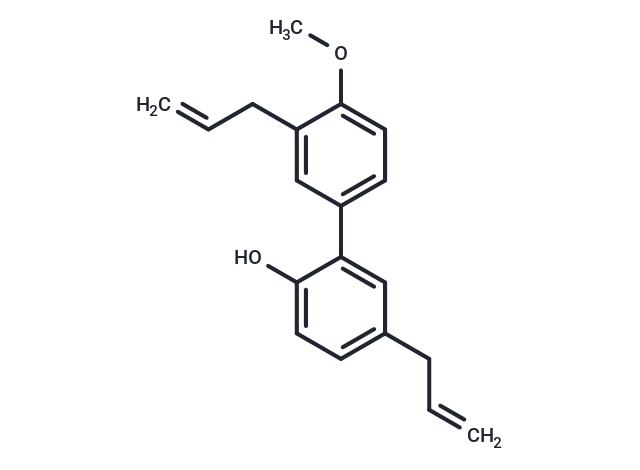Shopping Cart
- Remove All
 Your shopping cart is currently empty
Your shopping cart is currently empty

4-O-Methyl honokiol (4-O-Methylhonokiol) is a lignan-like compound obtained from Magnolia officinalis and Magnolia officinalis. It is a PPARγ agonist with antiangiogenic, anticancer, anti-inflammatory, and neuroprotective properties, and it can inhibit the activity of NF-κB, which can be used in cancer research.

| Pack Size | Price | Availability | Quantity |
|---|---|---|---|
| 1 mg | $52 | In Stock | |
| 5 mg | $123 | In Stock | |
| 10 mg | $197 | In Stock | |
| 25 mg | $373 | In Stock | |
| 50 mg | $556 | In Stock | |
| 100 mg | $798 | In Stock | |
| 500 mg | $1,650 | In Stock | |
| 1 mL x 10 mM (in DMSO) | $133 | In Stock |
| Description | 4-O-Methyl honokiol (4-O-Methylhonokiol) is a lignan-like compound obtained from Magnolia officinalis and Magnolia officinalis. It is a PPARγ agonist with antiangiogenic, anticancer, anti-inflammatory, and neuroprotective properties, and it can inhibit the activity of NF-κB, which can be used in cancer research. |
| In vitro | 4-O-Methyl honokiol (20 μM) increases the expression, transcription, DNA binding activities, and nuclear translocation of PPARγ in both prostate PC-3 and LNCap cells.[1] 4-O-Methyl honokiol (0-30 μM) inhibits LNCaP and PC-3 cancer cell growth, causes G0/G1 phase arrest, and induces apoptotic cell death, and such effects can be reversed by PPARγ antagonist. 4-O-Methyl honokiol inhibits NF-κB activity and cancer cell growth, but such effects as well as its activation of PPARγ can be abolished by knockdown of p21.[1] 4-O-methyl honokiol (0.5, 1, and 2 μM) reduces LPS-induced release of NO, PGE2, ROS, TNF-α, and IL-1β in cultured astrocytes, and amyloidogenesis in cultured astrocytes and microglial BV-2 cells.[2] |
| In vivo | 4-O-Methyl honokiol (40 or 80 mg/kg; i.p.; every day for 4 weeks) inhibits the growth of SW620 and PC3 tumors in the SW620 and PC3 xenograft model. 4-O-Methyl honokiol significantly increases the expression of p21 and PPARγ in the tumor tissues.[1] 4-O-Methyl honokiol (0.5 or 1 mg/kg; every day for 3 weeks) significantly ameliorates LPS-induced memory impairment and inhibits LPS-induced iNOS and COX-2 expression in mice. 4-O-Methyl honokiol also shows inhibitory activities against the Aβ1-42 accumulation and activates astrocytes and microglia in LPS-injected mice brains.[2] |
| Cell Research | Cells (5 × 10^4 cells per well) are plated onto 24-well plates. The cell growth inhibitory effect of 4-O-Methyl honokiol is evaluated in cells treated with 4-O-Methyl honokiol (0-30 μM) for 0-72 h, using an excluded trypan blue assay [1]. |
| Animal Research | Six-week-old male BALB/c athymic nude mice are used in the assay. SW620 and PC3 cells are injected s.c. (1 × 10^7 cells in 0.1 mL PBS per animal) into the lower right flanks of mice. After 20 days, when the tumors have reached an average volume of 300-400 mm3 or about 50 mm3, the tumor-bearing nude mice are i.p. injected with 4-O-Methyl honokiol (40 and 80 mg/kg dissolved in 0.1% DMSO) twice per week for 3 weeks. Cisplatin (10 mg/kg) is also i.p. injected once a week as a positive control. The group treated with 0.1% DMSO is designated as the control. The tumor volumes are measured with vernier calipers and calculated by the following formula: (A × B^2)/2, where A is the larger and B is the smaller of the two dimensions [1]. |
| Alias | 4-O-Methylhonokiol |
| Molecular Weight | 280.36 |
| Formula | C19H20O2 |
| Cas No. | 68592-15-4 |
| Smiles | COc1ccc(cc1CC=C)-c1cc(CC=C)ccc1O |
| Relative Density. | 1.054g/cm3 |
| Storage | store at low temperature | Powder: -20°C for 3 years | In solvent: -80°C for 1 year | Shipping with blue ice. | |||||||||||||||||||||||||||||||||||
| Solubility Information | DMSO: 80 mg/mL (285.35 mM), Sonication is recommended. | |||||||||||||||||||||||||||||||||||
Solution Preparation Table | ||||||||||||||||||||||||||||||||||||
DMSO
| ||||||||||||||||||||||||||||||||||||

Copyright © 2015-2025 TargetMol Chemicals Inc. All Rights Reserved.